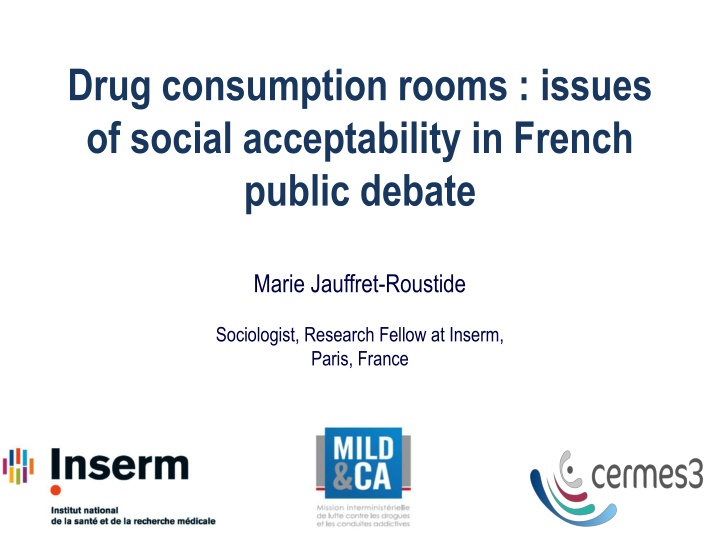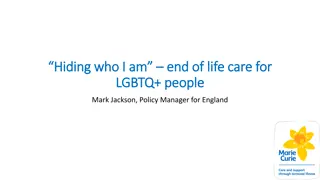
Social Acceptability Issues of Drug Consumption Rooms in French Public Debate
Exploring the social acceptability of drug consumption rooms (DCRs) in French public debate, this research discusses the hesitation in implementing DCRs despite their proven effectiveness in harm reduction. Strategies to address the high HCV prevalence among People Who Inject Drugs (PWIDs) in France are also examined, shedding light on the historical and current debates surrounding harm reduction policies.
Download Presentation

Please find below an Image/Link to download the presentation.
The content on the website is provided AS IS for your information and personal use only. It may not be sold, licensed, or shared on other websites without obtaining consent from the author. If you encounter any issues during the download, it is possible that the publisher has removed the file from their server.
You are allowed to download the files provided on this website for personal or commercial use, subject to the condition that they are used lawfully. All files are the property of their respective owners.
The content on the website is provided AS IS for your information and personal use only. It may not be sold, licensed, or shared on other websites without obtaining consent from the author.
E N D
Presentation Transcript
Drug consumption rooms : issues of social acceptability in French public debate Marie Jauffret-Roustide Sociologist, Research Fellow at Inserm, Paris, France
Public Health overview Compared to similar countries, France faces a high HCV (Hepatitis C) prevalence among People Who Inject Drugs (PWIDs) (64%). The latest epidemiological data shows an increase in health risk practices associated with injection (26% syringe sharing in the last month) and an important part of injections occurring in public places. This data shows that France faces a critical situation as injecting drug users are exposed to high levels of risk. The effectiveness of French harm reduction policy in decreasing HIV transmission has been proven, but the impact on HCV transmission is still limited.
French hesitations In order to have an impact on the HCV epidemic, it is crucial to consider new risk reduction measures that internationally, such as drug consumptions rooms (DCRs). have proved their effectiveness Despite the evidence, France has long been very hesitant to implement these facilities. The first consumption room opened in Paris 30 years after the very first DCR opening in Bern (Switzerland). Though we welcome the inauguration of the first DCR in Paris on October 2016, which has been followed by another opening in Strasbourg, we may wonder what reasons exist for this French delay. In this context, we have conducted the first sociopolitical study in France on the social acceptability of DCRs.
Methodology Analysis of media contents (2000 articles reviewed between 1990 and 2016) 70 face-to-face interviews with harm reduction professionals, political actors, and local residents 36 months of ethnographic observation in settings of public debate, especially at a local level In our work, we strove to study interactions between the local and national levels, We also focused on the way current actions and discourses borrow from past controversies, such as that on the implementation of harm reduction policy (access to syringes and OST) in the 80s and 90s.
A weak debate among professionals In the 80s and 90s, France was the scene of a fierce debate among health professionals concerning the implementation of harm reduction. Harm reduction challenged a prevalence of the psychoanalytical lens of analysis, the ideal of abstinence as the only option for recovery, and widespread fear of social control. Currently, debate over the benefits of DCRs is nearly nonexistent among professionals, as the majority are already convinced of the rooms usefulness. Thus, very few addiction professionals publicly oppose DCRs. When they do express opposition in the printed press, they use moderate language and sometimes choose to remain anonymous. The number of occurrences in the printed press reveals the tone of the debate as conveyed by the media: we found only 20 occurrences of neutral or opposing opinions by harm reduction or addiction professionals between 1995 and 2016, against 205 opinions in support of the rooms.
Arguments in the professional debate Economic argument: It would be more efficient to spend public money on hospitalizing drug addicts rather than on drug consumption rooms Scientific argument: We should not reduce the battle against drug addiction to risk reduction, and focus instead on understanding addiction as a problem in itself . The current debate draws on very few arguments from the preceding debate on harm reduction that was more focused on moral arguments. The current debate on drug consumption rooms is not determined solely by past arguments (80s debate on harm reduction), but it is a new interpretation of harm reduction policy and controversy in our current, specific time and place.
Political values Until now, in France, the most audacious harm reduction policies have been passed by right-wing governments. Access to syringes and OST were not a subject of debate in the political sphere, at the opposite of DCR. The lines of reasoning in the debate have been based on values distinctly associated with the political left and the political right. Right-wing arguments hinge on denouncing the way DCRs take away responsibility from individuals, excessive costs, and a refusal to renounce the ideal of drug eradication. Meanwhile, the left promotes a public health approach that should protect the most vulnerable members of society, and on values of intellectual tolerance towards others called civilized process . This confrontation of arguments shows that the debate on DCRs draws on broader political stances (liberal and conservative views vs. social and progressive views).
Local political commitment At the local level, two left-wing mayors (Paris and Strasbourg) decided to implement DCRs in their respective cities. The commitment of locally elected officials and mayors have been able to transcend national debate in order to implement the first DCR in France. However, at the local level, public forums organized by the 10tharrondissement city hall have been raucous, and dialogue with some resident associations has been difficult. The inscription of DCRs into public health law needed to be combined with local discussion between various actors (justice, police, politicians, and residents) in order to play a decisive role in appeasing local debate. The analysis of political debate reveals the impact of systems of local governance and local negotiations as opposed to top-down systems of government.
Local residents: ambivalence Local residents, along with drug users, are the first concerned by the implementation of a consumption room. Indeed, residents experience the implementation of the room in the environment of their daily life. Taking into account their experience and their perceptions is crucial. The discourse of residents is often caricatured in the media. The discourse of residents towards injecting drug users is ambivalent and oscillates between a wish that they had access to care ( It is crucial that drug addicts have access to treatment ) and a fear that a DCR will cause the social marginalization of their neighbourhood (NIMBY phenomenon) ( I am in favour of DCRs but not in my backyard ). Very few of them clearly express rejection of people who inject drugs.
The social environment sphere : local residents Thus, if opposition has been very intense and frontal among residents at the beginning of the debate, a major part of the residents seem to be more undecided and vigilant towards what will really happen in the future. In our work, it becomes clear that the lines of reasoning used by residents who oppose a DCR are sometimes close to those used by its advocates, but that they spring from a different positioning as well as different situations and interests. The main cause of daily concern for local residents is not always directly linked to people who inject drugs, but rather to the feeling that they (local residents) are living in a very marginalized area forgotten by the rest of the population and public authorities.
Conclusion Examining the different spheres (professional, political, local residents) allows us to understand how the debate on DCRs is framed and the way arguments are formulated in the public debate. When analyzing the debate, we used media analysis but also real-time, observation-based local debate situations and integrated evolutions across time, as well as past debates and debates at the national level. Thus, the debate on DCRs draws on constraints and resources already present in the harm reduction debate of the 1980s, but also repositions itself by avoiding frequent uses of moral arguments, witnessing less confrontation in the professional sphere, and making use of a softer argumentative tone in comparison with the harm reduction debate. Today however, we can observe a relocation of this debate from the professional sphere to the political and residential spheres.
Publications related to this oral presentation: Jauffret-Roustide M, Pedrono G, Beltzer N. Supervised Consumption rooms: the French Paradox. International Journal of Drug Policy 2013. http://www.ijdp.org/article/S0955-3959(13)00082-0/pdf Jauffret-Roustide M. les salles de consommation moindre risque : de l pid miologie la politique. La Vie des Id es, Janvier 2015. http://www.laviedesidees.fr/Les-salles-de-consommation-a-moindre- risque.html Jauffret-Roustide M. Les salles de consommation moindre risque : apprendre vivre avec les drogues . Revue Esprit, Novembre 2016. http://www.esprit.presse.fr/article/jauffret-roustide-marie/les-salles-de-consommation-a-moindre- risque-apprendre-a-vivre-avec-les-drogues-39012?folder=3#






















